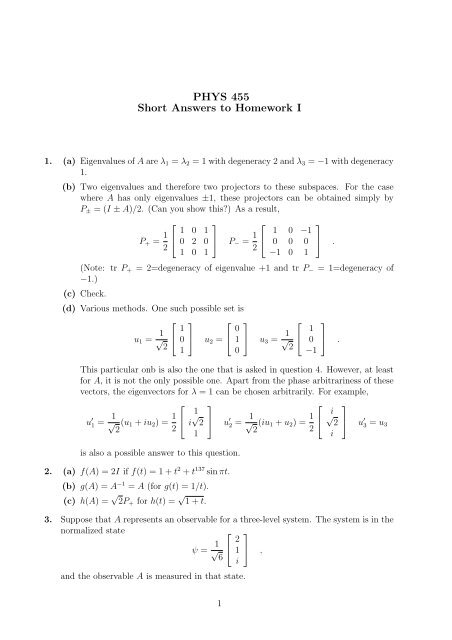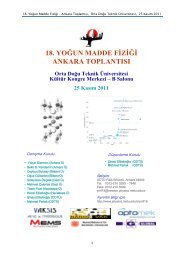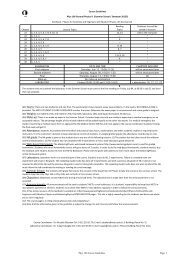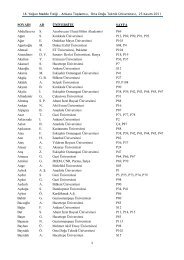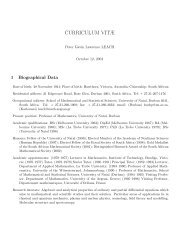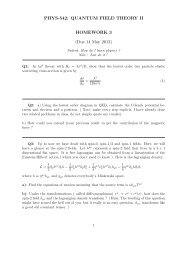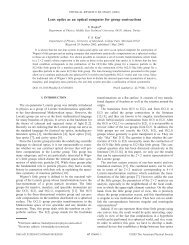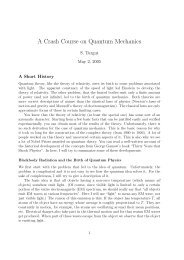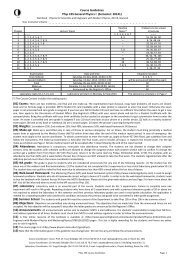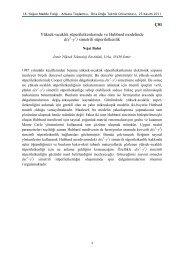PHYS 455 Short Answers to Homework I
PHYS 455 Short Answers to Homework I
PHYS 455 Short Answers to Homework I
Create successful ePaper yourself
Turn your PDF publications into a flip-book with our unique Google optimized e-Paper software.
<strong>PHYS</strong> <strong>455</strong><strong>Short</strong> <strong>Answers</strong> <strong>to</strong> <strong>Homework</strong> I1. (a) Eigenvalues of A are λ 1 = λ 2 = 1 with degeneracy 2 and λ 3 = −1 with degeneracy1.(b) Two eigenvalues and therefore two projec<strong>to</strong>rs <strong>to</strong> these subspaces. For the casewhere A has only eigenvalues ±1, these projec<strong>to</strong>rs can be obtained simply byP ± = (I ± A)/2. (Can you show this?) As a result,⎡P + = 1 ⎣21 0 10 2 01 0 1⎤⎡⎦ P − = 1 ⎣21 0 −10 0 0−1 0 1⎤⎦ .(Note: tr P + = 2=degeneracy of eigenvalue +1 and tr P − = 1=degeneracy of−1.)(c) Check.(d) Various methods. One such possible set is⎡ ⎤ ⎡ ⎤u 1 = √ 1 ⎣ ⎦ u 2 = ⎣2101010⎡⎦ u 3 = √ 1 ⎣210−1⎤⎦ .This particular onb is also the one that is asked in question 4. However, at leastfor A, it is not the only possible one. Apart from the phase arbitrariness of thesevec<strong>to</strong>rs, the eigenvec<strong>to</strong>rs for λ = 1 can be chosen arbitrarily. For example,u ′ 1 = 1 √2(u 1 + iu 2 ) = 1 2⎡⎣1i √ 21is also a possible answer <strong>to</strong> this question.2. (a) f(A) = 2I if f(t) = 1 + t 2 + t 137 sin πt.(b) g(A) = A −1 = A (for g(t) = 1/t).(c) h(A) = √ 2P + for h(t) = √ 1 + t.⎤⎦ u ′ 2 = 1 √2(iu 1 + u 2 ) = 1 2⎡⎣i√2i⎤⎦ u ′ 3 = u 33. Suppose that A represents an observable for a three-level system. The system is in thenormalized state⎡ ⎤ψ = √ 1 2⎣ 1 ⎦ , 6iand the observable A is measured in that state.1
(a) Values that can be obtained when A is measured are +1 and −1, namely theeigenvalues of A. In this particular case, both of these values are possible.(b) Probabilities of each possible outcome:P rob(+) = 〈P + 〉 = 〈ψ|P + |ψ〉 = ‖P + ψ‖ 2 = 712P rob(+) = 〈P − 〉 = 〈ψ|P − |ψ〉 = ‖P − ψ‖ 2 = 1 − P rob(+) = 5 12(1). (2)(c) If result +1 is obtained, then collapse is <strong>to</strong> the state P + ψ (which should berenormalized). In this case, the collapse occurs <strong>to</strong>⎡ ⎤1ψ + = √ P + ψ = √ 1 2 + i⎣ 2 ⎦ .7/12 142 − iSimilarly, if we obtain −1 as the result of the measurement, then collapse occurs<strong>to</strong>⎡ ⎤1ψ − = √ P − ψ = 2 √ − i 1⎣ 0 ⎦ = e iφ u 3 .5/12 10−1(The value of phase φ in ψ − is unimportant.)Another way <strong>to</strong> state this. Let us use the onb in 1(c). We can expand ψ in thisbasis asψ = c 1 u 1 + c 2 u 2 + c 3 u 3 = 2 √ + i u 1 + √ 1 u 2 + 2 √ − i u 312 6 12The first two terms is the component of ψ along the eigensubspace corresponding<strong>to</strong> λ = +1. The last term is the component along the eigensubspace corresponding<strong>to</strong> λ = −1. The norm squares of these components are probabilities andthe collapse occurs <strong>to</strong> these components. As a result, probability of obtainingmeasured value +1 is P rob(+) = |c 1 | 2 + |c 2 | 2 = 7/12 and the collapse occurs <strong>to</strong>√ (112 2 + iψ + = √ (c 1 u 1 + c 2 u 2 ) = √ u 1 + 1 )√ u 2 .P rob(+) 7 12 6The measurement will not destroy the coherence between u 1 and u 2 . The collapsewill occur <strong>to</strong> the coherent superposition expressed above (not <strong>to</strong> u 1 and not <strong>to</strong>u 2 ).Of course, what we described above for the collapse depends on the experimentaldetails of how A is measured. There are many different ways of measuring Awhere the collapsed states are different. (For example, measuring both A andB <strong>to</strong>gether as in problem 4. The collapse in that case is <strong>to</strong> u 1 , u 2 and u 3 withappropriate probabilities.) The mathematical scheme described here is calledprojective measurement and there are experimental methods that realizes this.This is important for example for local measurements done on entangled states.In that case, your local measurements and the collapse caused by them cannotdestroy the coherence in the rest of the wavefunction.2
(d) 〈A〉 = 1/6 and 〈A 2 〉 = 1. You can compute these by using already computedvalues of P rob(±).4. (a) Verify.(b) {u 1 , u 2 , u 3 } given in 1(c) is such an onb. Only the overall phases of these vec<strong>to</strong>rsare arbitrary now. Any superposition of these vec<strong>to</strong>rs is either not an eigenvec<strong>to</strong>rof A or not an eigenvec<strong>to</strong>r of B. Projection opera<strong>to</strong>rs can be obtained accordingly.(c) We use the expansionψ = c 1 u 1 + c 2 u 2 + c 3 u 3 = 2 + i √12u 1 + 1 √6u 2 + 2 − i √12u 3(or the projection opera<strong>to</strong>rs). The possible results obtained for both A and Band their corresponding probabilities are listed below.value of A value of B Probability Collapse <strong>to</strong>+1 +1 5/12 u 1+1 0 2/12 u 2−1 +1 5/12 u 33


